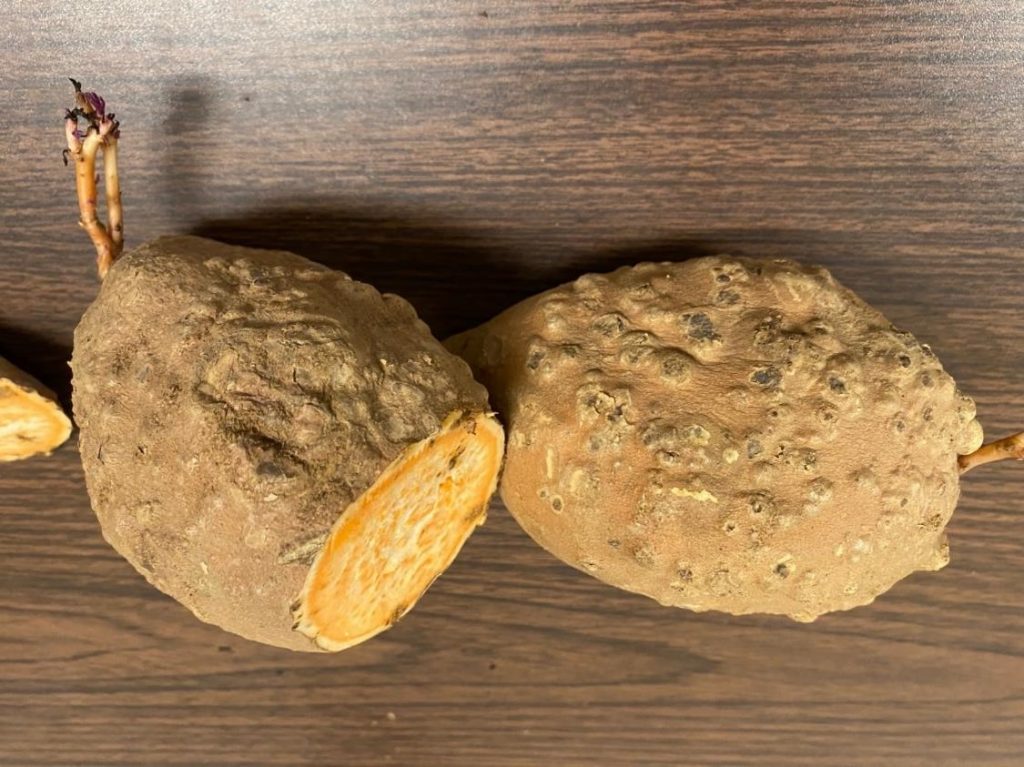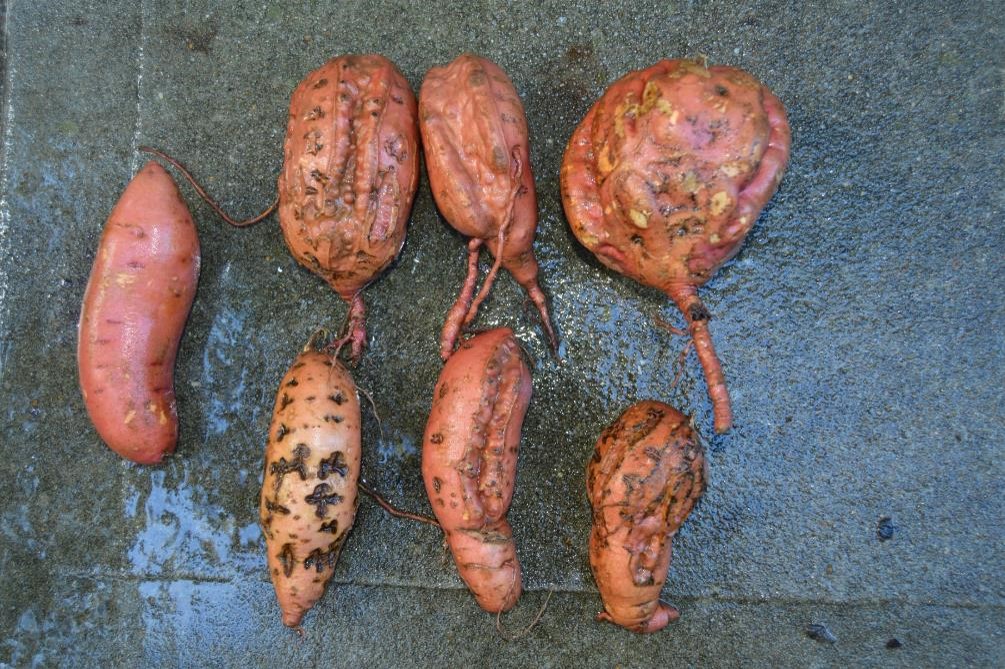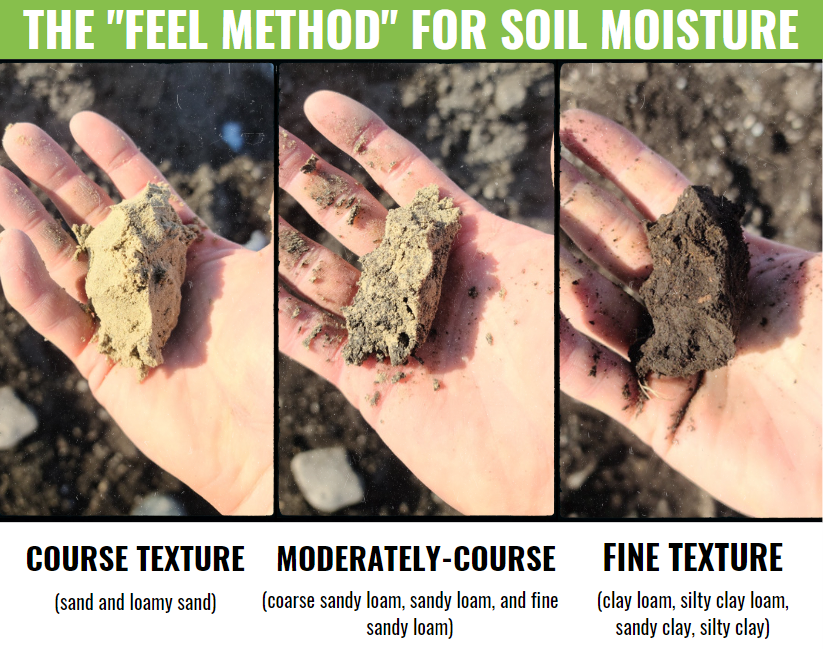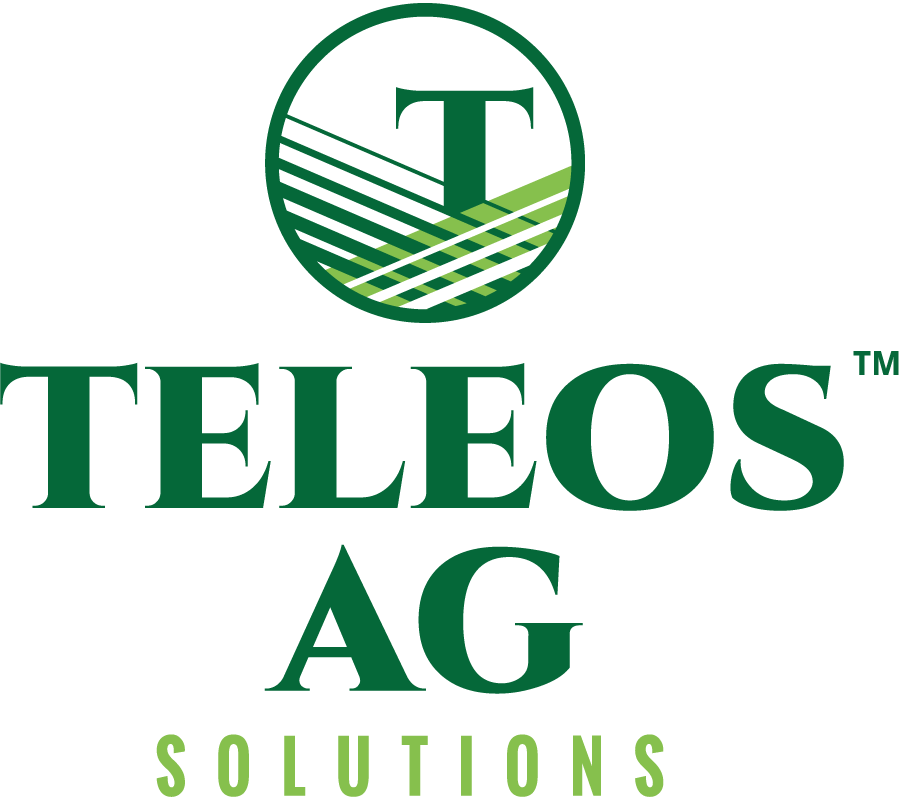This blog post will cover most common and destructive nematode affecting sweetpotatoes in North Carolina—the guava root-knot nematode— and recap a sweetpotato field trial that was done to demonstrate TELONE™ efficacy.
Let’s dive in!
The Problem
Nematodes are a common pest in sweetpotato-growing areas. They are typically found in coarse-textured soils. Root knot nematodes are the predominant species, with the guava root knot nematode (Meloidogyne enterolobii) being particularly destructive. These enterolobii nematodes are larger, more aggressive feeders that can easily overtake a field. They have a shorter (20-23 day) lifecycle compared to most root knot species (28-31 days), and there are currently no sweetpotato varieties resistant to enterolobii nematodes. Nematodes attack developing plant roots, resulting in damage that manifests itself in many ways throughout the season.


Soil Fumigation
Soil fumigants are injected into the soil as a liquid and quickly evaporate into a gas. The vapors move through soil pores and eventually dissolve into soil water. That movement through the soil is fundamental and essential to the effectiveness of fumigation for pest control.
“True” fumigants—such as TELONE™ soil fumigant—differ from contact nematicides in that true fumigants move through the soil on their own, rather than requiring water or incorporation for movement. Using TELONE™ to “prep” the soil ahead of planting forms a zone of protection with less nematode pressure. So, when tubers are planted, they can establish healthy roots and plants, offering more consistent results than contact nematicides. And because TELONE™ is applied to the soil before planting, it leaves behind no residuals and never touches the actual plant/crop.
TELONE™ Can Help
Due to the nature of nematodes—where they’re found, how they move, what affects them—the most effective product for control is a soil fumigant, such as TELONE™. There are currently no alternatives to match the efficacy of TELONE™ when it comes to managing nematode populations.
TELONE™ does more than just control nematodes, though. It allows sweetpotatoes to grow better and stronger. By creating a zone of protection around roots in the first 6 to 8 weeks of growth, TELONE™ allows roots to develop in an environment where nematodes are controlled and soil-borne diseases are managed. The result is extensive, healthy root systems capable of producing high-yielding, high-quality sweetpotatoes.
Proper Application to Maximize Benefits
In order to maximize the efficacy of TELONE™, be sure to adhere to the label’s application requirements.
- Applying TELONE™ at the correct soil depth, and at the correct soil temperature/soil moisture are key to ensuring TELONE™ can move through the soil freely, and at the right depth, to lessen nematode pressure.
- TELONE™ soil fumigant works best in seedbed-ready soils, free of clods and non-decomposed plant material.
- Applications of TELONE™ should be made at soil temperatures between 40˚ F and 80˚ F at depth of injection.
- Refer to label for full explanation, but in general, use the “feel” method to gauge proper soil moisture for application success.
- TELONE™ should be injected at least 12 inches below the final soil surface (measuring from the bottom of the outlet tube).
- Some applications require an injection depth of at least 18 inches.
- Read and follow all appropriate label instructions.

Field Trial Data
The field trial data shown below was collected in 2023 in Goldsboro, North Carolina. The trial was conducted to evaluate the efficacy of TELONE™ II (1,3-Dichloropropene) pre-plant soil fumigation for managing Guava Root-Knot nematodes in sweetpotatoes as compared to an untreated control. The test area covered approximately 0.6 acres and plots were 4 rows by 100 feet.
Marketable Yield & Nematode Counts At Harvest

KEY TAKEAWAYS: TELONE™ II @ 8 GPA treatment increased marketable yields by more than 10x as compared to untreated control. Nematode counts were reduced by more than 15x, allowing for more sweetpotatoes to mature into healthy plants and leading to higher marketable yields.
Galling & Number of Galled vs. Clean

KEY TAKEAWAYS: Root galling and galling severity were significantly lower in the TELONE™ II @ 8 GPA than untreated control. The TELONE™ II @ 8 GPA treatment increased the number of clean vs. galled more than 5x as compared to untreated control.
REMEMBER, THERE’S NO COMING BACK FROM A POOR START!
Visit www.TeleosAg.com to learn more.
Disclaimer:
The resources and information provided are meant purely for educational discussion, contains only general information about legal matters, and is not to be construed as advice. Please note that any information or resources provided are not legal or regulatory advice, and should not be treated as such. You must not rely on the information provided as an alternative to legal advice from your attorney or other professional services. Teleos Ag encourages readers to consult with counsel, and their local, county, and state regulators. We make no representations or warranties, express or implied, in relation to the information provided through our resources and blog posts. It is the readers responsibility to know the laws related to 1,3- D, appropriate PPE, Licensing, etc., in his or her City, County, State, and Country.
- TELONE™ USA R&D – Sweetpotato Field Trials 2024 - February 29, 2024
- TELONE™ USA R&D – Potato Field Trials 2024 - February 29, 2024
- TELONE™ Japan R&D – Watermelon Field Trials - February 29, 2024


